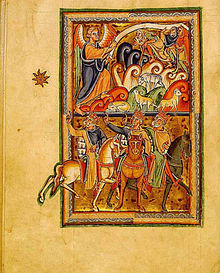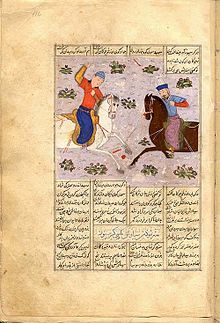Leiden University Library
| Leiden University Library | |
|---|---|
 Seal of the University Library in Leiden
|
|
| founding | 1587 |
| Duration | 5,200,000 |
| Library type | University library |
| place | Suffer |
| ISIL | NL-0200050000 |
| Website | http://www.bibliotheek.universiteitleiden.nl/ |
The Leiden University Library was founded in 1587 and is the University Library of the twelve years ago founded Leiden University . It is older than the Royal Library of the Netherlands and, as a source for teaching and research, had a significant influence on the sciences during the Age of Enlightenment . From a scientific point of view, the Leiden University Library is the most outstanding library in the Netherlands .
The library comprises approximately 5,200,000 volumes, including 10,000 contemporary series , 60,000 Oriental and Western manuscripts , 450,000 monographs , 70,000 diagrams , 100,000 book prints , 12,000 drawings and 120,000 photographs . Its Latin name is Bibliotheca Academiae Lugduno-Batavae .
It is based in the city of Leiden .
history
After the independence of the Republic of the Seven United Netherlands , the young Protestant republic needed a university of its own ; the choice fell in 1575 on Leiden and the then confiscated Catholic monastery. A library in the immediate vicinity of the lecture halls became an integral part of the university. The first book in the library was a polyglot Bible , a gift from Wilhelm I. The handover of this book is regarded as the basis on which the library is built (fundamentum locans futurae aliquando bibliothecae). On October 31, 1587, the Leiden University Library in the vaults of what is now the Leiden Academy Building (address: Rapenburg 73) was handed over to the University as operational.
In 1595 the so-called Nomenclator , the first catalog of the Leiden University Library, was published, which was also the first catalog of an institutional library in Europe . In 1864 an alphabetical catalog was completed for all works in the library since 1575, which existed until 1988.
In 1969, Johan Remmet de Groot was the 22nd librarian to initiate the automation of library holdings, which is now operated in the system by OCLC PICA . It carries approximately 400,000 microfilms and other electronic titles. In 1983 the Leiden University Library moved from the old town of Leiden to Witte Singel.
Special collections
Western manuscripts
The Collection of Occidental Manuscripts contains Old and Middle Dutch writings and manuscripts (including 2,500 medieval manuscripts and fragments and 25,000 modern manuscripts), 300,000 literary volumes, archives and 3,000 annotated prints from the university library, including the university archive.
Occidental prints
The Occidental Prints Collection of the Leiden University Library contains works printed before 1801 (including 700 incunabula) and rare and valuable works from after 1801. Over four centuries the collection has been expanded through acquisitions, gifts and bequests from scholars. In addition, the university library was given the right to deposit copies of all books approved for printing by the Republic of the Seven United Netherlands .
Bodel-Nijenhuis collection
The Bodel-Nijenhuis collection of the Leiden University Library mainly contains old diagrams, atlases and topographical prints and drawings. Most of the works come from a legacy of the lawyer Johannes Tiberius Bodel Nijenhuis (1797–1872), a member of the Dutch Literature Society for 25 years. He was a passionate collector of cartographic and topographic drawings.
Oriental collection
The Oriental Collection of the Leiden University Library, also known as Legatum Warnerianum , referring to a legacy of 1,000 Hss. From the Middle East by Levinus Warner (1619–1665), the emissary at the high gate in Constantinople , which is still the core of the Forms collections.
From the beginning of the library until today, Oriental Studies has been one of the most important areas of work at Leiden University. Theologians studied Semitic languages to interpret the meaning of the Bible. Linguistic scholars such as Joseph Justus Scaliger , Johannes van den Driesche (Drusius) and Jacobus Golius contributed to the importance of the chair. This radiated into the Protestant countries in particular. A close exchange was maintained with foreign students, such as the Zurich scholar Johann Heinrich Hottinger . He compiled a catalog of the library's Arabic manuscripts. For political and economic reasons, the young Dutch Republic developed relations with the enemies of its enemies, including the Ottoman Empire , which was then at the height of its time. In the course of its expansion policy, Holland secured possessions in Indonesia . Dutch merchants were the only Europeans to maintain a permanent trading post in Japan. The Oriental Collection is a center for scientists from all over the world.
The Oriental Collection today contains 30,000 manuscripts and 200,000 printed books on subjects (including the Leiden Papyrus X ) from archeology to Zoroastrianism and in languages from Arabic to Zulu.
Bibliotheca Thysiana
The Bibliotheca Thysiana of the Leiden University Library houses a collection of around 2,500 books and thousands of pamphlets, bequeathed in 1655 by the lawyer Joannes Thysius (1622–1653) . After his untimely death, he left a legacy of 20,000 guilders for a public library building. The Bibliotheca Thysiana is the only surviving example of a library building in the Netherlands from the 17th century and is protected as a Rijksmonument .
Scaliger Institute
The Scaliger Institute of the University Library in Leiden was founded in 2000 with the aim of promoting the use of the various collections for both teaching and research. For this purpose, the institute offers the best working conditions, such as lectures, computer programs and special courses. It also awards grants to scientists who want to work in Leiden for some time.
The institute was named after the most famous Leiden scholar Joseph Justus Scaliger (1540–1609). At the early University of Leiden he was one of the greatest patrons of the university library, and after his death bequeathed it an extraordinary collection of manuscripts and books.
Librarians
Since the university was founded in 1575, there have been 25 library directors at Leiden University Library:
|
|
Locations
literature
- Christiane Berkvens-Stevelinck: Magna commoditas. A history of Leiden University Library, 1575-2005 . Primavera Pers, Leiden 2004. ISBN 90-5997-005-5
- Christiane Berkvens-Stevelinck: Magna commoditas - Leiden University's great asset. 425 years library collections and services . Amsterdam, Leiden University Press, 2012. ISBN 9789087281656 [Rev. Edition]
See also
Web links
- University Library Leiden (Dutch)
- Leiden University Library
- Digital Special Collections Leiden University Library
- Scaliger Instituut (Dutch)
- Scaliger Institute
Individual evidence
- ↑ Levinus Warner's Oriental Collections. Accessed October 9, 2016
- ↑ Monument number: 25479
Coordinates: 52 ° 9 '26.9 " N , 4 ° 28' 54.9" E











